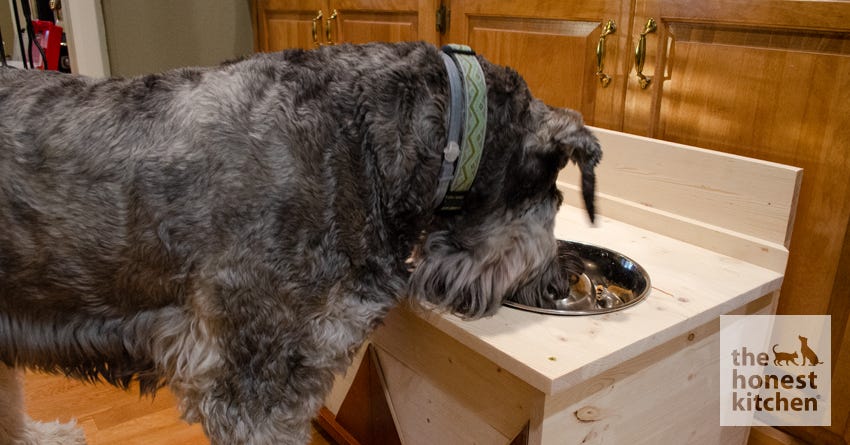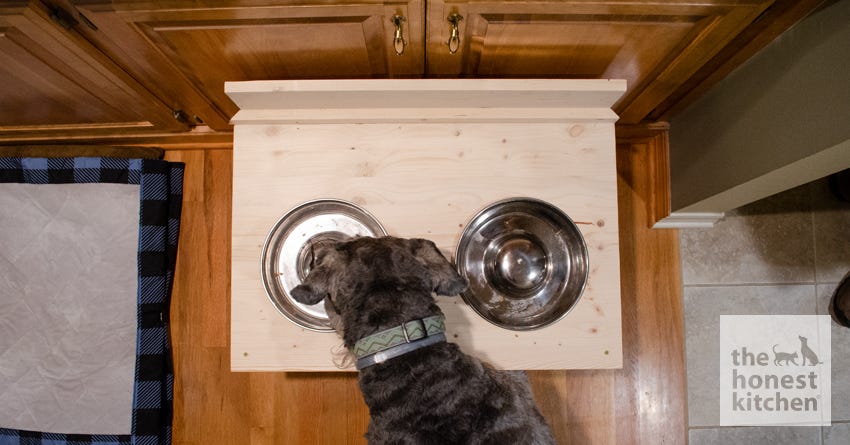Elevated dog bowls can be a great idea for some dogs.
Other dogs might not need them. Most dogs simply don't care. If you're wanting to get an elevated dog bowl for your pooch but can't find one you like, make one! I used my Giant Schnauzer, Hildie, as the model for this project, but its forever home is with my woodworking associate's Collie/Labrador mix, Tumble. (Hildie is just a couple inches taller, but about 40 pounds heavier. She was very supportive! Lots of treats were awarded.) Before we dive into it, let's list out a few reasons why you might want an elevated dog bowl.
Why would I want an elevated dog bowl?
Medical Conditions: Dogs with certain medical conditions, like arthritis, back problems, or a stiff or sore neck, can benefit from a bowl that is raised off the floor some. Dogs that suffer from megaesophagus, which makes it difficult for them to swallow, can benefit from a raised bowl. Voracious Eaters: Dogs who scarf down their food might slow down a bit when eating from an elevated dog bowl. Combine it with a slow feeder and it should really hinder your dog's ability to inhale his food. Ease for Owners: Dog owners who find it difficult to put the bowls on the floor may find a benefit to raised bowls. Bowl Chasers. These set-ups also tend to stay put, so your dog won't end up chasing his food bowls around to get those last few tasty tidbits. Paddling/Burying: Some dogs that were bred for swimming will paddle or try to swim their feet in their water bowls. Other dogs try to "bury" their food (even though there's nothing to bury it with). This not only makes the floor a mess, but it also makes it hard to keep bowls filled with water and even food. An elevated bowl might stop this tendency. Other Paws Off: If you have multiple dogs (and cats) who like to steal each other's food, sometimes separating heights of the bowls might reinforce teaching them to stop stealing food.

Different dog sizes call for different sized bowls. If you have a short dog, then your "elevated dog bowl" will be barely off the ground. If you have a giant, it will be over a foot off the ground.
Simple or Complex?
Before you head into this project, decide now: how complicated do you want to get? I was originally wanting to go simple: just a board with circles cut into it for the bowls to hang from, and some sort of legs. Quick, easy, take me an hour or two—I'd spend more time with the pretty details than the structure. But what if you want to add more to it? Shelves, drawers, lids? We decided to go crazy—make a box with a drawer. This meant a whole heck of a lot more measurements and things to go wrong. And almost everything that could go wrong, did. For the sake of this tutorial, I'll make sure to hit on the highlights that you should watch out for, and things to keep in mind no matter what kind of dog bowl you want.

Wood, bins, slides, bowls. Not pictured: the drawer base and all the screws. | photo by Thomas Mulcahy
Materials Needed:
I made mine out of wood. You clearly can make it out of all sorts of materials, using whatever you can find. For a simple wood elevated dog bowl, you'll need: wood, screws, bowls (with a substantial lip), something to make a hole (jigsaw), drills, and a whole lot of measurements. If you want to add a drawer or shelves, you'll clearly need to get a bit more creative. Honestly, my end result was quite large—but it was as small as I could make it with the slides I already had, and the bins and bowls we wanted to use. The specifics of the wood and screws depend upon the measurements you take. The stuff I bought:
- one 16" x 72" stain-ready pine board
- one 20" x 72" stain-ready pine board
- two 9" bowls (I found slow feeders, because the Collie/Labrador inhales food)
- two 8.5" x 15.5" x 12" bins
- drawer and slides salvaged from scrapped cabinet
- ~twenty 1" screws
- bigger screws as desired (I used a combination of 1" and 2", as I like my stuff sturdier)
- stain
- handle
Required Materials: The goal of an elevated dog bowl is to get the bowl...elevated. The easiest option would be a slab of wood big enough to cut holes into for the bowls to sit in, then affix some sort of legs—this simply gets the bowls off the ground, accomplishing your goal.
Measurements to Note:
- The height of your dog from ground to chest, particularly when sniffing or eating (my Giant Schnauzer is about 15 inches)
- Diameter of dog bowls (right below the lip)
- Height of dog bowls
- Thickness of the boards (depending on how you do it, your screws will need to be tiny—so be sure to measure before buying screws!)
- Any other things you want added to this contraption (in my case—dimensions of the bins and slides)
Required Measurements: Make sure you get the top of the bowls up to about chest height, which means the legs need to be about that high.

The bins fit perfectly in the drawer, so we made the whole structure based on these dimensions. | photo by Thomas Mulcahy
Building Your Elevated Dog Bowl
Once I got my measurements ready, it was time for some shopping. I had a lot of screws and tools, so all I needed was some wood, bins, and bowls. I was in a time crunch, so I didn't have the luxury of buying cheaper stuff and making my own boards—so in total, it cost me about $120. With screws and tools included, it would definitely be more. But I was committed. (This is why pre-made, real wood furniture costs so much...) Find a sizing reference point. I used the bin size and the already made shelf with slides as our reference point. The bins fit perfectly on the drawer, which was semi-planned. We have the outer dimensions of the box! Based on the height of the bins, bowls, and dog, we wanted the bowl's top to sit at around 14 inches. We trimmed 2" off the long edge of the 16" board, then cut it down for the sides and back.

The sides attached to slides, with the strip below. | photo by Thomas Mulcahy
If making a drawer, get the drawer off the ground. The trimmed 2" went in two strips along the bottom of the box—that way it gave us a place for fuzzy feet and got the drawer off the ground. Once the 2" trim was put below the drawer slides, we screwed the slides into the sides. (If you use slides, make sure to use proper-headed screws. I used ones that were too big at first, and had to redo all the screws, wasting half an hour—screw up one.) We cut the 20" board for the back, measuring it to go right behind the sides. (We were going to put it in between the sides, but we messed up some measurements which forced it back an inch—screw up two. We also decided to keep the height on it as a backsplash—this was laziness turned into genius.)

Sides, back, and front affixed. | photo by Thomas Mulcahy
We cut the 16" board for the drawer front, trimming its top and sides. (We could've made the front one of a dozen ways. In the end, we went with a super simple option—putting a board right on top of what we had and recessing it into the box. Also, I used 3" screws instead of 2" to affix the front to the drawer—a mistake which jacked up the wood a bit, resulting in screw up three.) For the top, we took the 20" board and cut it to width. We wanted it to overhang about an inch on the sides and front. (I measured the cut wrong and we lost an inch on the depth—screw up four. So we used some of the spare trim as a little backsplash accent to patch it up.)

Fancy geometry to find where to put the holes. | photo by Thomas Mulcahy
Cut the holes for the bowls. Now for the fun part: the bowl holes. Using some geometry, I figured out where I wanted the holes to go. I drilled the biggest holes I could with my drill first, then finished it off with a jigsaw.

The bowls fit! The holes weren't perfect, but got the job done. | photo by Thomas Mulcahy
The drawer was a bit flimsy, as I expected. I didn't have enough extra space between the bins and the edge to put a full drawer on, so I used some braces (the interior with the bins has almost no wiggle room, which was perfect). The trim laying around was perfect for this when cut at 45º angles.

45º angle braces, because otherwise opening the drawer wouldn't work. | photo by Thomas Mulcahy
We sanded it all down, because splinters suck. Then affixing the top. If I had more time, I would've built a hinge for it—but alas, I just had to screw it on.

Sanding. And the bins fit perfectly! | photo by Thomas Mulcahy
To cover up my 3" screw mishap, I found some thin wood in my scrap pile and tried to get fancy with it. It was super time crunch at this point, so it didn't turn out how I hoped—but it worked well enough. After staining, it'll look good enough.

Usable for now! Hildie waiting patiently for her treats. | photo by Thomas Mulcahy
At this point, it's usable! Hildie loves it. Or at least the treats we put in it.

Staining made the funky cover-up designs less jarring. | photo by Austin Conley
If staining or painting, use food-friendly materials. For final touches, it's staining time. We went darker with it, to match the dark scrap wood we used. There's all sorts of options out there for this—paint or stain, and a thousand shades of each. But whatever you do, make sure it's not toxic. Your dog's face will be all over this thing, so make sure it smells as little as possible, and isn't harmful if licked. And of course, a handle. If this will be on hardwood floors, put some feet cushions on the bottom, too.

The bins doing work! | photo by Austin Conley
Fill up the bins with some kibble and toys, and you're all set! We got lucky with the bin sizing—you can barely remove the bins when the whole thing was screwed together (screw up five). Building a hinged top would've solved this problem.

Perfect height for Hildie. | photo by Thomas Mulcahy
And we're done! Doggo approval.

Tumble loves it, too! Bonus points for the elevated and slow feeder combo slowing down his food scarfing. | photo by Austin Conley


